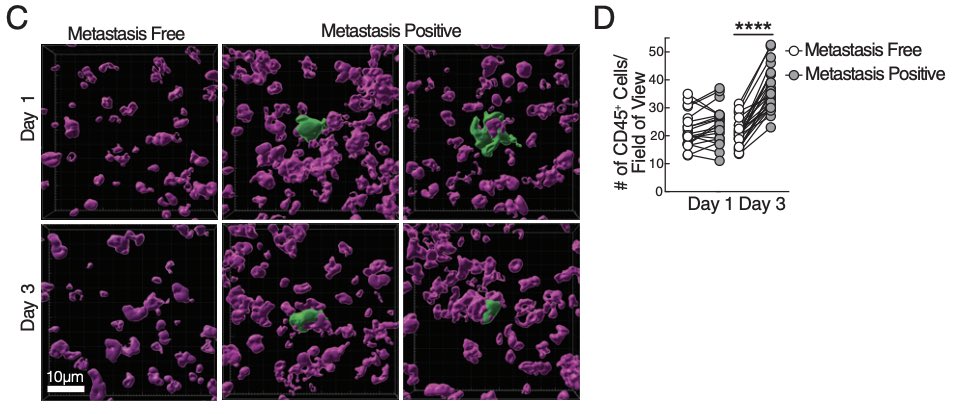The Innate Immune System Recognizes Metastatic Cells
Weizmano et al. have found that type 2 dendritic cells and natural killer cells orchestrate very early immunity against metastatic cancer cells in the lung. Learn more about the research in this blog post!

Prof. Akiko Iwasaki
We study innate and adaptive immunity against viruses and study disease pathogenesis. #COVID19 #longCOVID #vaccines @HHMINEWS @YaleIBIO @YaleMed @YaleCII

-
Does the innate immune system recognize metastatic cells and control their growth? @weizmano et al found that type 2 dendritic cells and natural killer cells orchestrate very early immunity against metastatic cancer cells in the lung 👇🏽 (1/)https://t.co/dwSxaaSgD7
— Prof. Akiko Iwasaki (@VirusesImmunity) March 8, 2023 -
Adaptive immune system is important to ultimately eliminate cancer cells. However, what happens in the first days after metastatic cells arrive in a target tissue? @weizmano looked at the first 3 days after metastasis and found leukocyte recruitment around the cancer cell. (2/) pic.twitter.com/oOaK1ynAmo
— Prof. Akiko Iwasaki (@VirusesImmunity) March 8, 2023 -
Next, @weizmano used various mice with depletion in dendritic cell types and found that CD11b+ dendritic cells (but not monocytes, CD301b+, or DC1) were required to contain the rapid growth of metastatic cells. (3/) pic.twitter.com/HI7OwwsEVy
— Prof. Akiko Iwasaki (@VirusesImmunity) March 8, 2023 -
There are a number of dendritic cell subsets with distinct functions and locations. https://t.co/0CcaXyAGCQ
— Prof. Akiko Iwasaki (@VirusesImmunity) March 8, 2023
The role of DC1 in inducing anti-tumor T cell immunity is well known. However, we found here that DC2 are important before adaptive immunity can take place. (4/) pic.twitter.com/S1PZLaE2Wt -
How do DC2 block metastatic cell growth? One thing that DC2 do but not DC1 is that DC2 secrete cytokines IL-12 and IL-23 in response to metastatic tumor challenge. (5/) pic.twitter.com/HjsD56v25h
— Prof. Akiko Iwasaki (@VirusesImmunity) March 8, 2023 -
How do DC2 detect metastatic cells? These cells use both DNA and RNA sensors and adaptors (cGAS, MAVS) and signaling (IRF3/7) to produce IL-12. (6/) pic.twitter.com/mYt6j2eQOt
— Prof. Akiko Iwasaki (@VirusesImmunity) March 8, 2023 -
How do DC2-produced IL-12/23 cytokines block tumor growth? It turns out another cell type is involved - NK cells! NK cells that are resident in the lung produce IFN-g in response to metastatic challenge but this requires DC2 and viral sensor signaling pathway and IL-12. (7/) pic.twitter.com/FsEbIBQi07
— Prof. Akiko Iwasaki (@VirusesImmunity) March 8, 2023 -
This is a snapshot of DC2 and NK cells caught in the act. Metastatic tumor cells (green) are surrounded by NK (red) and DC2 (white). (8/) pic.twitter.com/SnlmJKhgnR
— Prof. Akiko Iwasaki (@VirusesImmunity) March 8, 2023 -
Our data show that once metastatic cancer cells enter the target organ (e.g. lung), DC2 detect these invaders by their DNA and RNA. Nucleic acids trigger sensors that activate DC2 to produce IL-12/23, stimulating NK cell production of IFN-g and blocking tumor growth. (9/) pic.twitter.com/Tgs3uefh4I
— Prof. Akiko Iwasaki (@VirusesImmunity) March 8, 2023 -
While our study reveals a basic mechanism of metastasis control in mice, it opens up new avenues for prevention and treatment. Efforts to enhance the ability of DC2 and NK cells to prevent metastatic disease may be a promising avenue. (10/)
— Prof. Akiko Iwasaki (@VirusesImmunity) March 8, 2023 -
Congratulations to @weizmano Sophia Luyten Irina Krykbaeva @ericsongg @tianyangmao @MarcusBosenberg on this important study 👏🏼 👏🏼 👏🏼 @YaleIBIO @Yale_CIO @YaleCancer @YaleMed (end)
— Prof. Akiko Iwasaki (@VirusesImmunity) March 8, 2023
